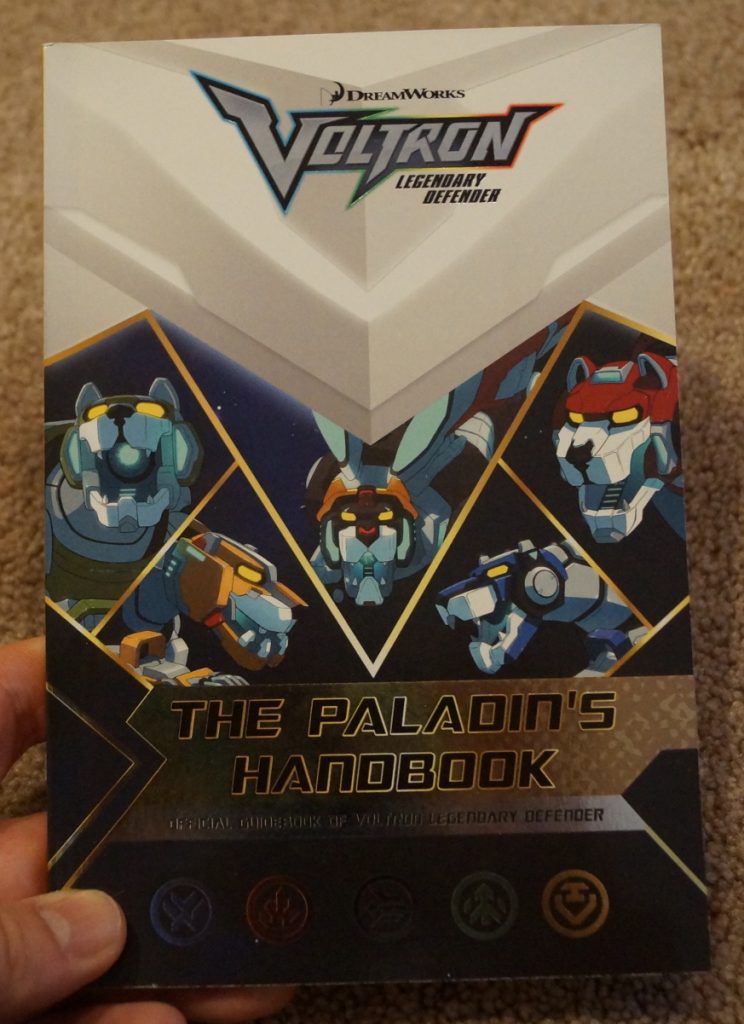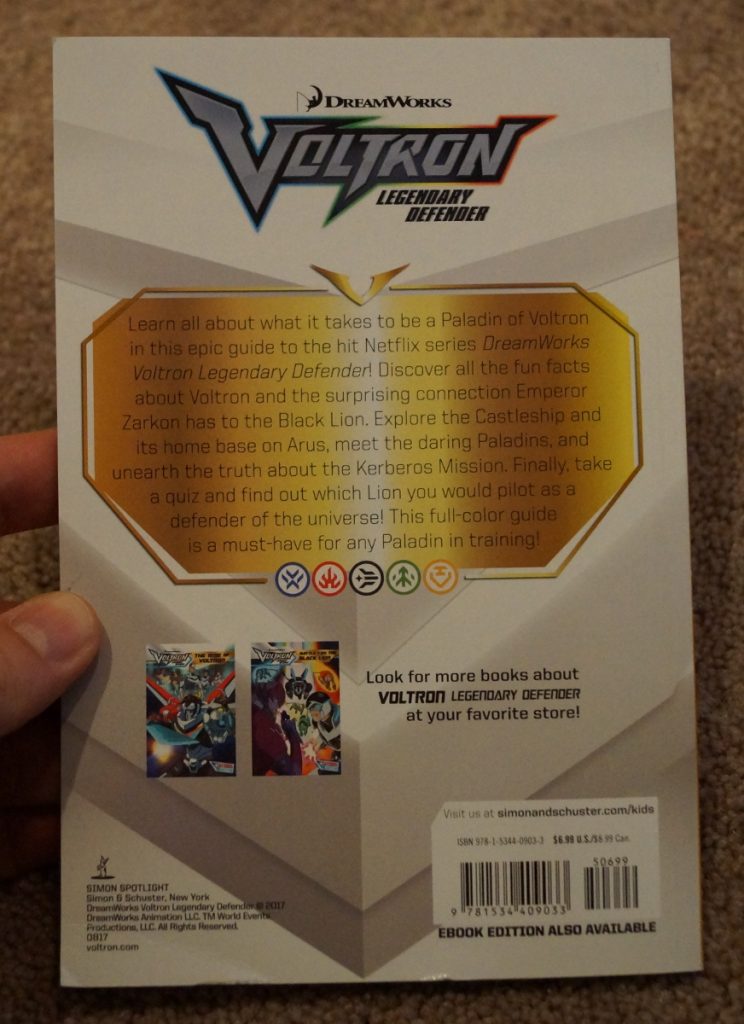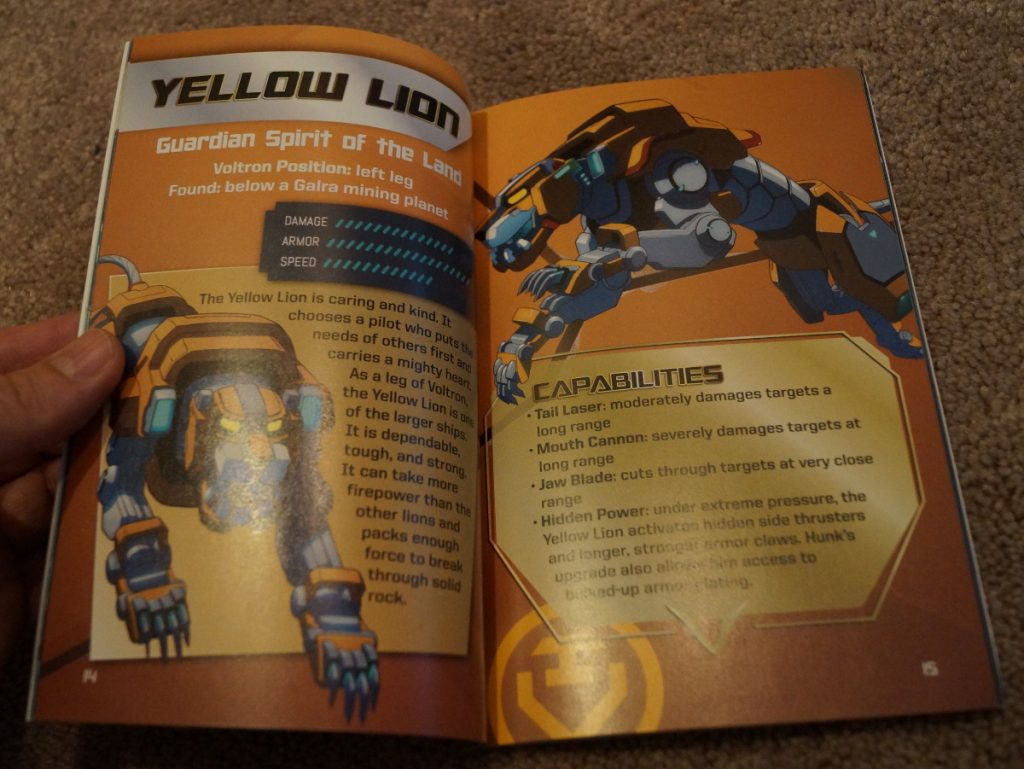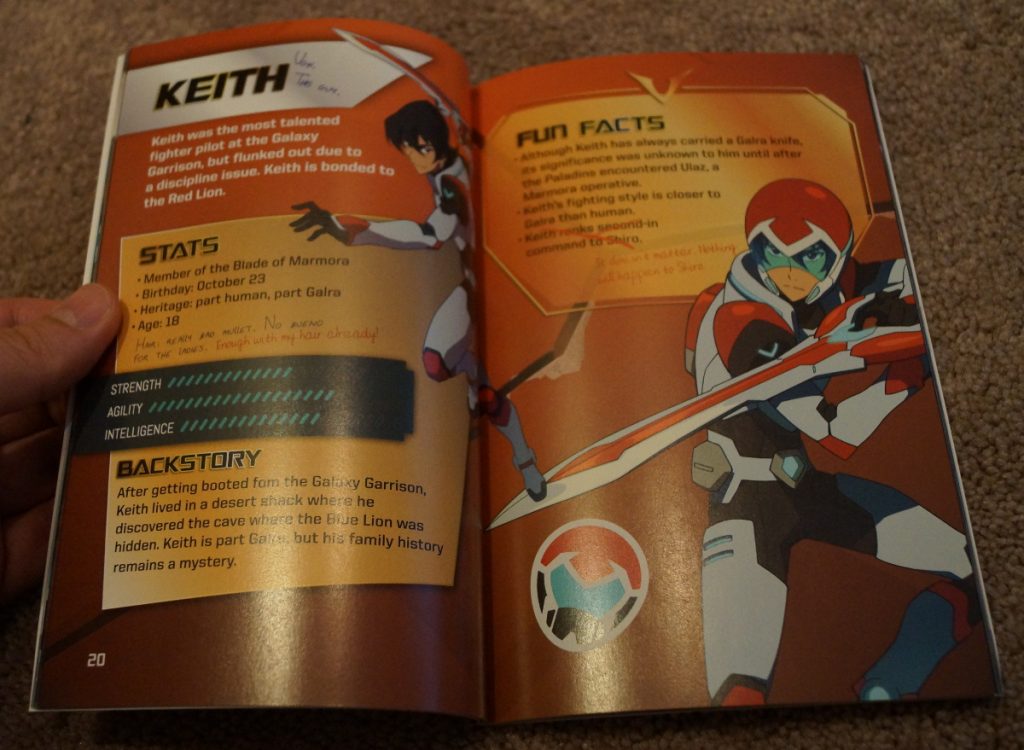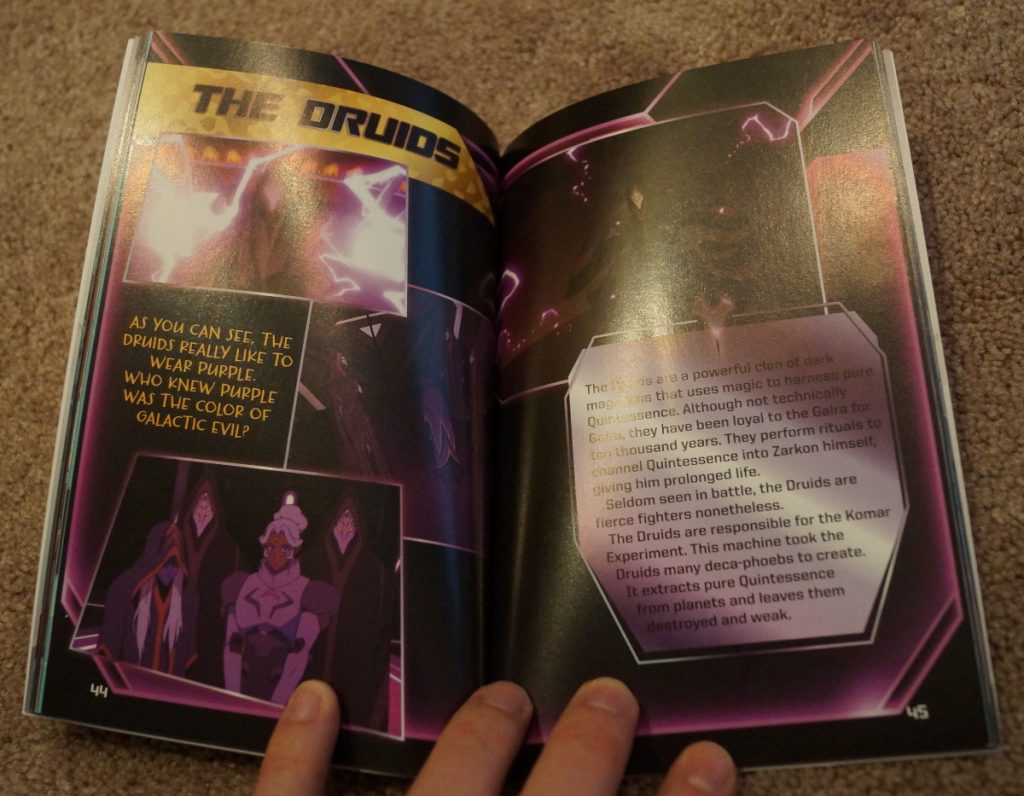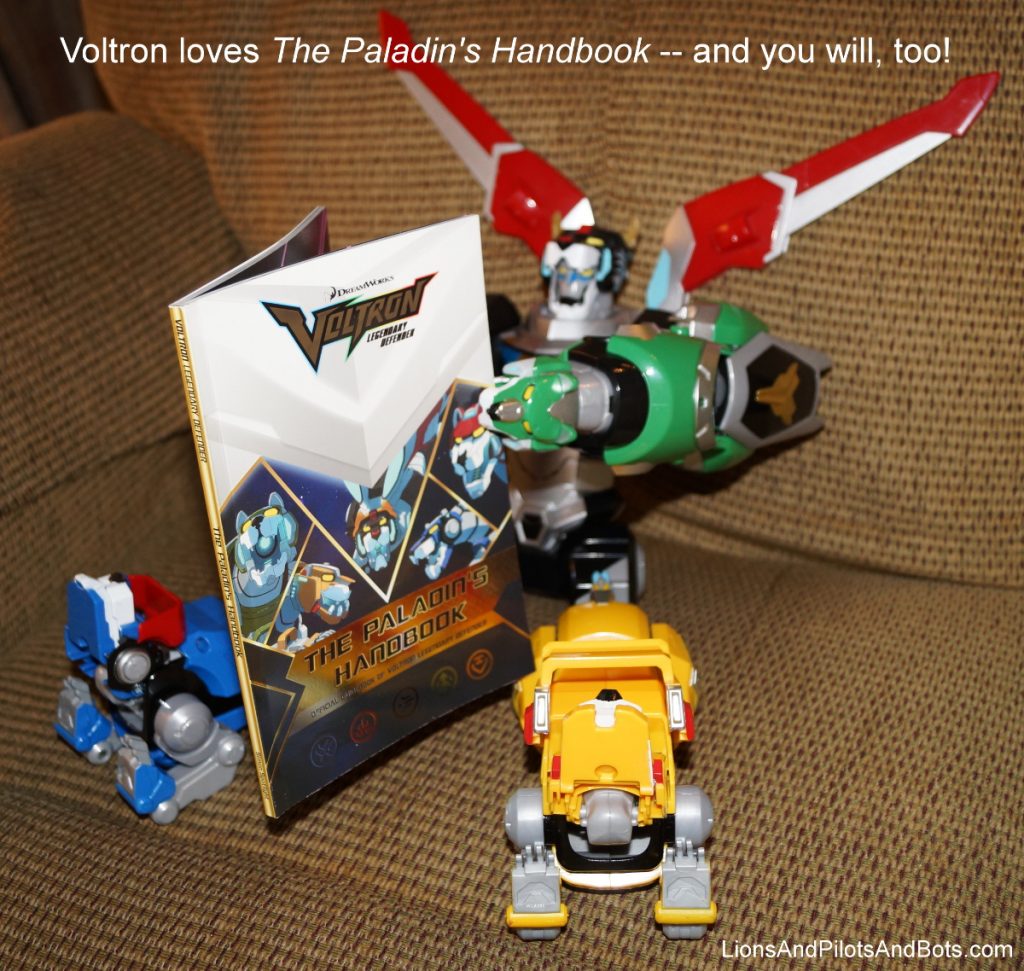I’m a junkie for what I call the “meta-fiction reference” book — that is, a fictional universe reference book that treats that universe as if it were real. As a long-time Star Trek fan, I’ve considered the gold standards for such books to be Bjo Trimble’s classic Star Trek Concordance and Michael and Denise Okuda’s Star Trek Encyclopedia. These books tend to be hundreds of pages in length, with glossary-like alphabetized, illustrated entries, containing cross-references to other entries.
Books of this nature that are written for child readers tend to contain more illustrations and less text, and they tend to cover material with less depth. They’re also more casual and less formal in tone. In their own way, these books can be just as enjoyable to the adult reader as the larger works that tend to cater to an older reader base.
DreamWorks Voltron Legendary Defender: The Paladin’s Handbook (ISBN 978-1-5344-0903-3) is an example of the child-oriented category, and I’m pleased to say that it’s a good one. At 96 highly-illustrated pages, the book contains just enough information to satisfy most younger readers, and it has an attractive design that encourages a reader to read the book from cover to cover. It’s a decent primer to many people, places, and works of technology within the fictional universe depicted in the first two seasons of the television series Voltron Legendary Defender.
Strangely, this book has no credited author or illustrator. The only credited person is Julie Robine, who bears a “Designed by” credit, and you have to read the mice type on the page opposite the table of contents to find this credit.
As I mentioned at the beginning of this review, this book is an example of what I call a “meta-fiction reference.” It covers the Voltron Legendary Defender universe, and it’s written as if that universe were real. The book is written from the perspective of Princess Allura, Coran, and the five Paladins as of the end of the series’ second season — Shiro, Keith, Pidge, Lance, and Hunk. To lighten the tone, the book’s “real” text is often accompanied by notes that are designed to appear hand-written by individual characters. The “hand-written” notes of a given character are rendered in a distinct color and type face that, for the most part, gives an authentic hand-written feel.
The book is laid out as follows:
Welcome, Young Paladin!
This is a single-page introduction to the book, written by Princess Allura. It explains the motivation for the book — to explain what it’s like to be a Paladin of Voltron, in order to guide a reader on his or her Paladin journey. The page is also signed by all seven heroes, establishing the color and style of each character’s “handwriting.”
Meet the Lions
This section provides a brief, two-page description of each Lion. This section is light on hand-written notes, sticking mostly to facts.
Meet the Paladins
This section gives two-page coverage to Shiro, Keith, Pidge, Lance, Hunk, the Bayards, and Voltron. Hand-written notes can be found in plenty here. Highlights include:
- Next to the Shiro “Fun Fact” that “Shiro returned to Earth with a streak of white hair and a scar across his nose,” the words “white hair” are circled, and there’s a note from Shiro that reads, “Stress can do some pretty terrible things.”
- On Keith’s page, there is hand-written banter between Keith and Lance, concerning Keith’s mullet.
- On Pidge’s page, there is hand-written commentary from Hunk and Pidge explaining that “Katie Holt” is Pidge’s real name, and “Pidge Gunderson” is just an alias.
The Team
This section covers King Alfor in a single page, and it devotes two pages to Princess Allura, and two to Coran. The only hand-written note in this section is a lengthy one on the Coran pages, written by Coran himself. Needless to say, it’s a funny read.
The Galra Empire
This section gives a two-page description of Emperor Zarkon, Haggar, and the Druids. It devotes a single page to each of Commander Sendak, Commander Prorok, Robeasts, and Prince Lotor. Very little information is given about Lotor, since this page was written as of the end of the second season, and Lotor makes his debut in the third season. Amusingly, there are notes from Lance on the Lotor page, mostly concerning Lotor’s hair.
The Blade of Marmora
This section gives an overview of the Blade of Marmora as an organization, as well as the Trials of Marmora, which are undergone by would-be members. It also gives single-page descriptions of Kolivan, Ulaz, Thace, and Antok.
Explore the Universe
This section describes the Castle of Lions, the planet Arus, the Balmera, the Baku, the planet Taujeer, the Space Mall, the planet Altea, the Galaxy Garrison, and what the Galaxy Garrison knows about the ill-fated Kerberos Mission, which had led to the disappearance of Shiro, as well as Pidge’s father and brother.
Learn to Speak Altean
This section gives a run-down of the very few Altean terms that have been revealed in the TV series. It also covers the Galra phrase “Vrepit sa,” and it covers various Altean time units.
Important Information for Your Paladin Journey
This section could just as easily be called “Miscellaneous.” It covers quintessence, the teludav, the weblum, and Fraunhofer lines. The Fraunhofer lines page feels extraneous, but the other pages feel appropriate to the book.
Quiz: Which Lion Will You Pilot as a Paladin of Voltron
This is a short, ten-question, multiple-choice quiz that is supposed to give the reader an idea of which of the five Voltron Lions would be the best fit for the reader, if he or she were to become a Paladin of Voltron.
Overall, this book is a fun read. I do have some minor nits to pick with it, which I’ll cover in the near future, but as a primer or refresher, this book would be great to add to the collection of any fan of Voltron Legendary Defender, and it might even be a good gift for an old-school-only Voltron fan, to give him or her a taste of what he or she would have in store if he or she were to try watching this fun new series. I highly recommend this book for Voltron fans of any age.

